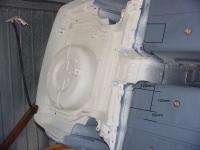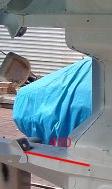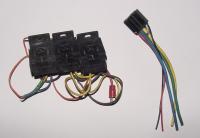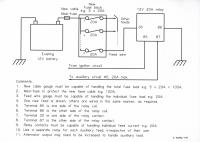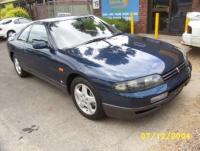Everything posted by Nissanman
-
240z Alternator
The ammeter is there to indicate what is happening to the battery. If the meter reads in the negative, the battery is discharging into a load. If it reads in the positive, the battery is being charged by the alternator. Any direct connection from the battery to the alternator output, effectively shorts out the ammeter. Therefore, the above two conditions are no longer indicated. Normal operation with engine running etc. is a float voltage of ~13.8V, causing the ammeter to read just to the + side of zero. To see the ammeter "dancing" is an indication of a wildly varying load and is demonstrating how effective the regulator and alternator are in compensating for that load. As long as the battery gets a charge, all is well:classic:
-
240z Alternator
I've said it again and I'll say it before: - Make sure you run any additional electrical load via correctly rated fuses, relays and correctly dimensioned wiring. Having a pseudo nuclear power station as an alternator is fine but don't expect existing [factory] wiring to enjoy the new load you want to give it. "Protection is very important", said the Bishop to the ActressROFL
-
Ammeter
What you describe is an impending failure. The regulator is losing the plot. If not repaired, this condition may lead to overcharging of the battery, resulting in loss of electrolyte and possible, remote but, explosion of the battery. Burning out of globes, overloaded fuses and general global warming are also possible:ermm: Get the electrics checked by a competant Auto Electric Shop if you are not confident in this area. The alternator output will ramp up when revs. increase but it is the duty of the regulator to, you know, regulate If you are not into originality, might be a good time to adopt an internally regulated alternator and dispose of the old click clack relay type regulator.
-
Starting Problems -
All's well that ends well:) Something like that tests yor patience AND your sanity:tapemouth
-
Differential removal
Might be best if you remove the diff. housing with the moustache bar still attached [assuming it is still in the car]. Once out of the car you can get a decent go at the retaining nuts. They screw on to studs which screw into the rear cover. If one of the nuts is stripped, just cut it down with a grinder until it falls away. The studs can be renewed, but if you are clever enough you shouldn't damage it with the grinder:nervous:. The Haynes manual calls them "differential rear mounting bolts" but they are really screw in studs with a nyloc nut.
-
Starting Problems -
If you accidently put the new battery in backwards, i.e. postive to earth, negative to car, that will rupture any fuseable link the alternator. From then on it is zip, zero, diddly squat until that link is repaired:tapemouth
-
Floor pan support brackets info
-
Floor pan support brackets info
How sad is THIS:nervous::nervous: That car is STILL up on the rotisserie:tapemouth Anyhoo, rear panel is 220mm x 120mm tapered to 100mm at the rear as per pic. Located 50mm inboard of the edge of the floor rail. Front hole is 460mm from the edge of the T/C rod mount. Not critical in location, 10mm diam and only a drain hole.
-
Need a ignition switched electrical source
Something a bit closer to you folks in the States: - http://www.painlessperformance.com/assets/07Catalog/page38.pdf
-
Starting Problems -
When you say "the same thing happens", I assume you mean the car starts, runs, but when left overnight the battery goes flat. There may be a load on the battery even when you turn off the key. That is easily determined, and avoided, by disconnecting the battery terminal after you shut the car off. Next time to start it, re-connect the terminal and see how the battery performs. Barring another stuffed battery, it should be alive and well. Once it starts, you need to check the charging function of the alternator. See: - http://www.classiczcars.com/forums/showthread.php?p=211105#post211105 If there is a load draining the battery overnight, you need to investigate as what and where. It might be as simple as a radio/tape player or rear de-mister left on. Fuse pulling is the quickest and simplest method to narrow it down. Then you might have to go to plug pulling etc. A car will run for quite a while on the battery alone and the alternator alone for that matter, until you try to restart it:tapemouth
-
Need a ignition switched electrical source
The relay bases on the left are Bosch slide together type and have part number #3 334 485 008 stamped on them. The base on the right is pre-wired and you can just see the diode mounted below the connectors.
-
Need a ignition switched electrical source
Fuse blocks: - http://www.narva.com.au/Fuses_16.html Relays: - http://www.narva.com.au/Switches_18.html There are some relay bases which clip together to create a nice "bank" of relays. Try your local wrecking yard and see if you can find them. Also, use relays which have a protection diode [or resistor] connected across the coil. This prevents the back e.m.f. of the relay, when it releases, generating a voltage spike into the wiring . The diode makes the relay polarity conscious but the spike suppression is well worth the effort. If you have ever chased electrical gremlins in electric door locks and alarm systems, you'll know what I mean:finger: Any relay socket can be modified to insert this diode [resistor], which then means you don't have to use the relays with the protection built in. Depending on design, relays and fuse blocks should be OK in the engine room. Just avoid heat, oil and water splash. If you have the real estate available, inside the cabin would be ideal. My advice is DO NOT use Nissan relays. They seem to be a design all on their own. Stick to the more conventional types like Narva, Bosch, Hella etc. which use the 30, 85, 86, 87, 87A pinouts. The last thing you need is some weird arse wiring requirement which applies to one relay type only:ermm:
-
Need a ignition switched electrical source
-
electrical problems after paint
A continuity check with an Ohm meter should ONLY be done on an unenergised circuit. To check power you should use a Voltmeter. Just trying to prevent a fried meter or confusing results:finger:
-
electrical problems after paint
Well,you've let some smoke out and that is a no no:( Couple of possibilities: - a fried or broken a power wire, a fried or broken blower motor a fried or broken speed control resistor device If the blower works on full speed but not at reduced speed, the speed control resistor or switch could be kaput. You really need to do some voltage measuring on the relevant connectors to see when and if you lose the 12V supply. [The blower fuse a likely suspect, check it again with a Ohm meter for continuity, or a voltmeter for 12V]
-
Help!!!
If you suspect the fuel, why not check the level in the float bowls prior to cranking the engine? They should be full from the last time it ran. If they are empty then the fuel is draining away somewhere. That would introduce a time delay until the carbs. re-filled. [An electric pump would still need time to do what the mechanical pump is doing now, you just won't be cranking the engine] At the same time you could disconnect the fuel pump outlet hose and check that the pump spews out fuel when you crank it. Needless to say, TAKE CARE AND NO SMOKING From what you describe, it does appear to be a fuel issue.
-
door reinforcements
Like he said. The bar runs to the lower pair of screws of the door catch. It is some distance from the outer door skin, ~25mm, so it's not as if it contacts anything apart from the mounts at the front and rear panels. The very top of the door has a double panel that may cause you grief. It extends down from the window slit by about 70mm but the lower edge is still ~10mm from the outer skin. It has some Nissan chewing gum here and there to bond the lower edge to the outer skin. Guess where my door is dented:cry:
-
Front Main Seal replace
The seal can be removed without removing the timing/front cover. Fiddly, but achievable. If you do anything on the timing chain etc. then the front cover does have to come off. 4 x 6mm bolts clamp the sump to the front cover. Not something that I have done on an engine still in the car:eek: The crank seal is usually pressed in till the front edge is flush with the cover, it doesn't bottom out on anything as such. There is a weeny ledge about 20mm in, but if you press the seal in that far I'm guessing it will have gone in too far. The depth of the cover at the hole is only about 8mm and the seal is about the same width. You may not need to adjust the seal depth, just inspect the crank pulley suface with this in the back of your mind:nervous: Pic. shows front cover seal area and sump bolts x 4. I just happened to have an L24 front cover next to my 'puter!!
-
Front Main Seal replace
No.1 Water pump. Easy enough to do, just be careful getting all the fasteners out. If they are corroded, it may be wise to renew them with a stainless bolt kit from a vendor. No. 2 Front main seal. The design of the crank is such that the main seal runs on the O.D. of the crank pulley. That means that once you remove the crank pulley, there is ample room around the inside circumference of the seal to hook it out with the appropriate tool. Re-insertion of a new one could be achieved without removing the radiaiator. If you are doing the water pump, may as well pull the rad. and give yourself better access. Note the condition of the surface of the crank pulley where the seal rubs. If it is badly grooved, the new seal will have an issue from day one. Either have a speedi-sleeve fitted to the pulley OR re-insert the new seal to a different depth that the old one was. Then the lip on the new seal will have a fresh surface to seal against. Strongly suggest you use a shop manual to get some baground info. before you start:nervous: Pic. shows seal and crank diameters.
-
Electric fan not turning on!
You really need to determine the power source for the fan. It can be either direct from the battery, or from an ignition type circuit [via protective fuse and relay]. The former will allow the fan to run at all times, depending on the fan thermostat/sensor operation. The latter will be only when the key is in the "ON" position, plus thermostat/sensor operation. Then, as mentioned above, the thermostat needs to be reliably attached to either the radiator metal work [e.g. top tank]or immersed in the coolant flow. If the thermostat is adjustable, it need not be very complicated in its mounting since the device can be adjusted to switch the fan on at your desired temperature. For it to come on ONLY when the engine is shut off is undesireable. Either the power source is incorrect, or the thermostat is set far too high and only heat soak after shutdown is operating it:ermm:
-
Have all R33 gtst's been thrashed
Mine was advertised at $17K, I offered him $16K and deal was done. This was back in May, 2005. My wife has lost the ability [desire] to drive a manual and the auto was just great so I didn't mind it a bit. Car was very well looked after, absolutely stock as a stone. It had been sitting after compliencing for some 6 months until I saw it on their web site. It is getting old now too but so what:rolleyes: The 1986 Commodore I had was in an advance state of leprosy, it had to go:(
-
Highly recommend it
Here is a check list I posted on an Oz site some time ago re wipers: - 1) Disconnect the wiper arm linkage from the rear of the motor, switch it on and check it has reasonable slow and fast speeds. YES/NO? 2) Now check the mechanical linkage, you should be able to operate the wipers by rotating the motor arm by hand. (Lift the arms off the screen or remove them to eliminate drag on the glass.) YES/NO? NO to 1) means motor is tired. NO to 2) means that the pivots and linkages need a damn good lubing! Fixing the pivots is relatively easy, just be patient in getting them apart if they are dry and corroded. Lots of CRC-556 and gentle pressure over several days and they should eventually come apart. There is, or should be, a wuzzy little circlip on the end of the shaft, remove and ditch it. Replace it with a decent external circlip from CBC. Wire brush the shafts, thoroughly clean the tubes, lube it all with PH Zinc Oxide grease, check for smooth rotation and finally fit new weather boots to the shafts. Applies to any car really:classic: As a point of interest, later model Nissans have nylon wiper pivot bushings which will "never" require maintenance. My 1985 B120 ute and my 1993 R33 Skyline have these. Alloy housings + steel shafts + time + corrosion = :tapemouth
-
Need a ignition switched electrical source
If you can't read this properly , email me and I'll send you the original file.
-
Need a ignition switched electrical source
- Have all R33 gtst's been thrashed
Bought a 1993 R33 GTST back in 2005. Had ~60,000K on the clock. Stock as a rock, with 4spd auto. Best car I've ever had or driven:) Being auto, all the boy racers avoided it, to my advantage. I'm sure you could get a decent one if you "ordered" the car from a reputable importer. Mine was for sale in Adelaide but was complied in Brisbane. - Have all R33 gtst's been thrashed
Important Information
By using this site, you agree to our Privacy Policy and Guidelines. We have placed cookies on your device to help make this website better. You can adjust your cookie settings, otherwise we'll assume you're okay to continue.





